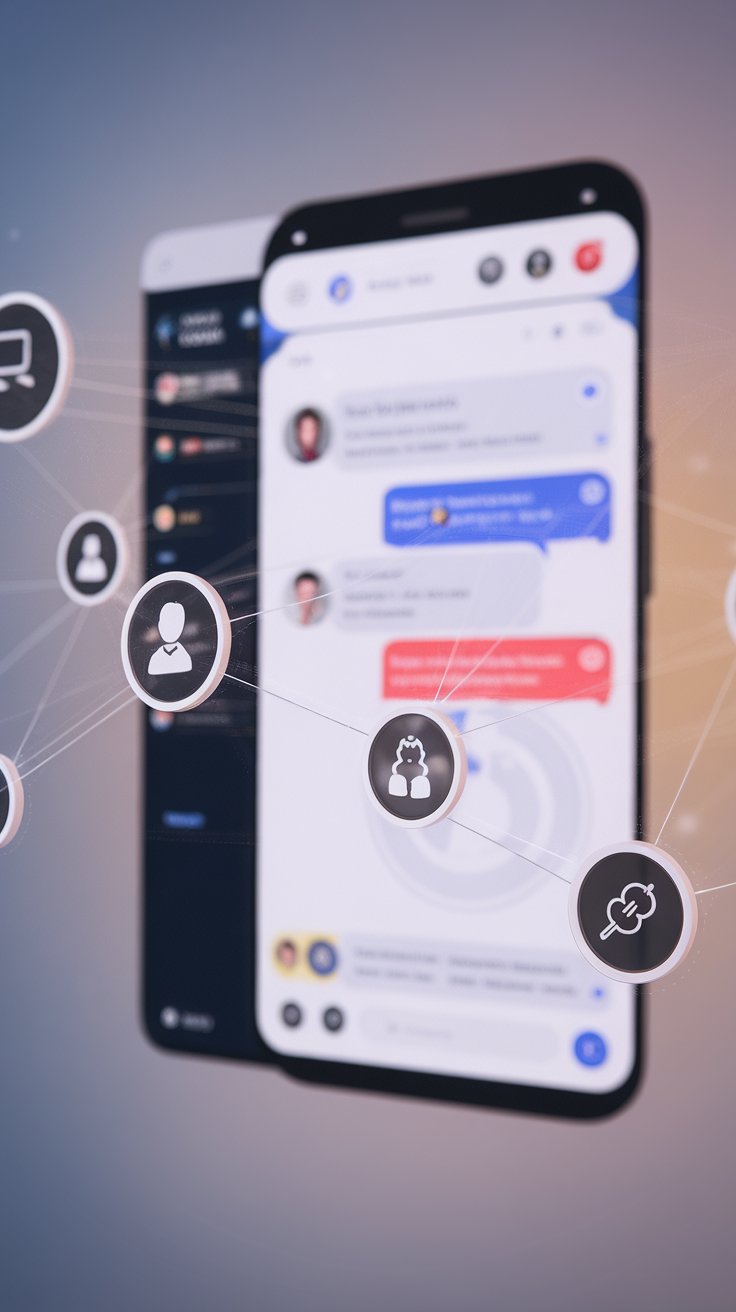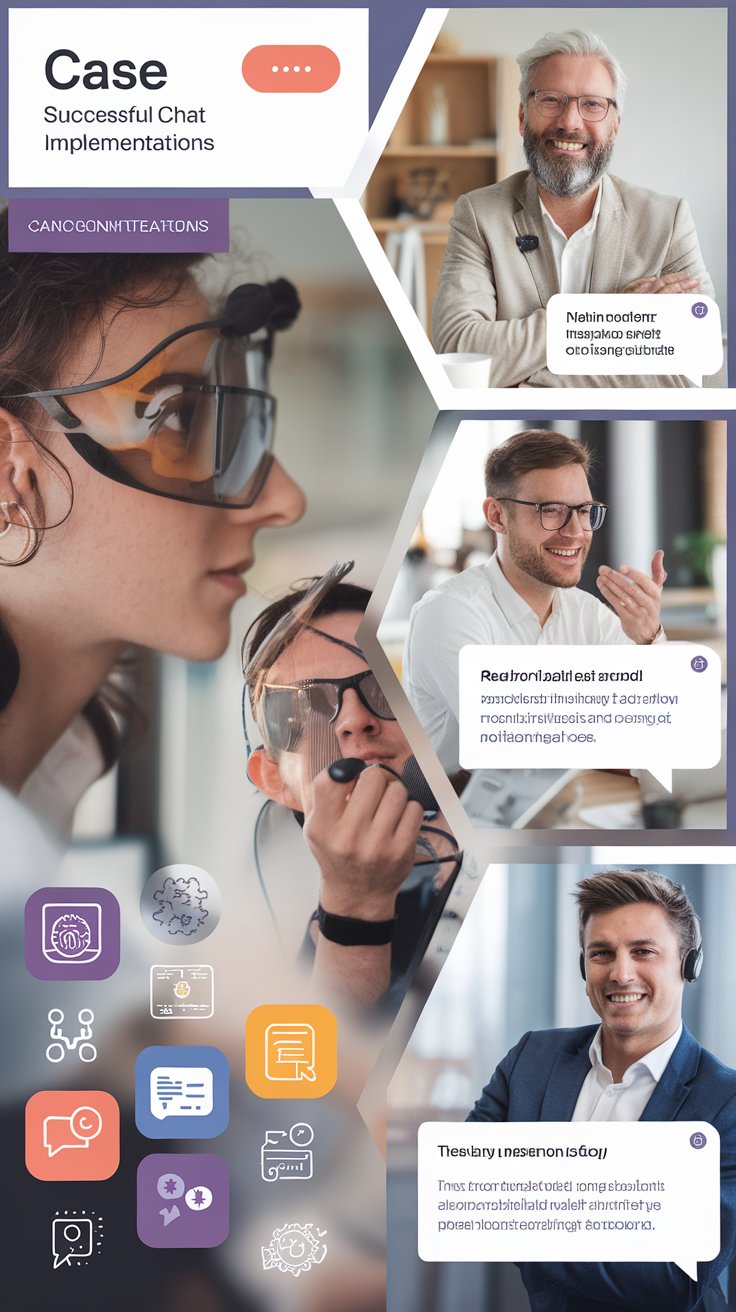Introduction
In today’s digital landscape, enhancing user interaction through effective chat connection tactics has become pivotal for websites aiming for a compelling user experience. The ability to communicate directly with users not only facilitates immediate support but also fosters a sense of connection and community. As more businesses recognize the importance of engaging their audience, implementing effective chat strategies is no longer an option but a necessity. This article explores various chat connection tactics that ensure a more engaging website experience for visitors.
From integrating automated chatbots to real-time customer support, the methods of enhancing visitor interaction will be scrutinized in detail. By employing these techniques, websites can create more meaningful connections with their audience, enhance customer satisfaction, and ultimately drive higher conversion rates. Let’s delve into the essential strategies that can help transform a standard website into an interactive hub that keeps users coming back for more.
Understanding the Importance of Chat Connections
As the online landscape becomes increasingly competitive, chat connections emerge as a vital element for fostering user engagement on websites. These connections allow businesses to bridge the gap between users and their services, ensuring that visitors feel supported and valued during their online journey. By establishing effective chat connections, websites can create an interactive environment that encourages exploration, inquiry, and ultimately conversion.
Chat connections can take various forms, each playing a unique role in enhancing user experience. Live chat, for instance, offers real-time communication between users and customer service representatives, making it an ideal solution for immediate inquiries and support. Users can quickly receive assistance, share concerns, or ask questions, which helps to alleviate any friction during their browsing experience. This immediacy fosters a sense of trust and satisfaction, which is crucial for retaining visitors.
Chatbots provide a consistent level of support without the need for live human agents. These automated solutions can be programmed to answer frequently asked questions, guide users through the purchasing process, or even schedule appointments. By utilizing chatbots, websites can ensure that users receive assistance 24/7, which is particularly advantageous for businesses with a global reach. Furthermore, chatbots can handle a high volume of inquiries simultaneously, making them an efficient solution for managing user engagement at scale.
Another emerging form of chat connection is through messaging apps, such as WhatsApp or Facebook Messenger. These platforms allow businesses to communicate with users through channels they are already familiar with, promoting a seamless experience. By integrating messaging apps into their websites, businesses can facilitate more personalized interactions, leveraging users’ preferred communication methods. Additionally, this approach allows for asynchronous communication, giving users the flexibility to respond at their convenience.
The way these different chat options affect how users feel about their experience online is really important. When people feel listened to and backed up, they’re more likely to stick around on the site, check out what’s there, and come back later. By carefully mixing in different chat strategies, businesses can boost user involvement and make their online presence feel more lively, which can lead to happier customers and better chances of making sales.
Types of Chat Strategies Enhancing User Engagement with Live Chat Chatbots and Messaging Apps
Varieties of Chat Solutions to Boost User Experience
Websites harness a range of chat strategies designed to foster better engagement and interaction with users. Each strategy serves distinct functions and appeals to diverse user preferences, ultimately enhancing the overall website experience. The three primary types of chat solutions employed on websites are live chat, chatbots, and messaging apps, each offering unique advantages and applications.
Live chat is a real-time communication tool that allows users to engage with a customer service representative or support staff instantly. This approach creates a personal connection and can significantly influence user satisfaction. The immediacy of live chat can transform the customer experience, resolving queries and concerns quickly. Research shows that customers are more likely to make purchases after having a positive interaction with a live chat agent. Therefore, implementing live chat can lead to increased conversion rates and customer loyalty.
On the other hand, chatbots serve as automated assistants, capable of addressing common inquiries without human intervention. They can operate 24/7, providing instant responses to users, which is invaluable for businesses looking to maintain a constant online presence. Chatbots employ natural language processing to understand user intents, making them increasingly sophisticated. They can handle repetitive tasks, freeing human agents to tackle more complex issues. Effectively deployed, chatbots can enhance user experience by ensuring that even after business hours, users feel attended to and informed.
Messaging apps, such as WhatsApp or Facebook Messenger, bring a different dimension to website chat strategies. These platforms allow users to engage with businesses in a more familiar and comfortable environment. By integrating messaging apps into their overall communication strategy, businesses can meet users where they already spend time. This approach enhances accessibility and fosters ongoing conversations, encouraging users to return for future interactions. With the ability to send images, documents, or even voice messages, messaging apps extend the chat experience beyond the limitations of traditional web chat.
Incorporating these varied chat strategies enables businesses to create a dynamic and responsive interaction environment. By understanding the strengths of each type—live chat for instant human connection, chatbots for efficient automation, and messaging apps for user convenience—organizations can tailor their approach to optimize user engagement and satisfaction.
Implementing Chat Connection Tools StepbyStep Guide to Boost User Engagement
Integrating chat connection tools on your website can significantly enhance user engagement. These tools allow seamless communication and create a personalized experience for visitors. This guide outlines a structured approach to implementing various chat connection tools effectively.
Step 1: Identify User Needs
Before selecting a chat tool, assess your users’ needs. Conduct surveys or user interviews to understand their preferences. Pay attention to the challenges they face when seeking assistance on your site. This data will guide you in choosing the right chat solution that aligns with user expectations.
Step 2: Choose the Right Chat Tool
Based on your research, select a chat tool that fits your audience’s requirements. There are several options:
- Live Chat Software: Ideal for instant communication with users. Examples include Zendesk Chat and Intercom.
- Chatbots: These automated systems can handle frequently asked questions and operate 24/7, providing support without human intervention.
- Messaging Apps: Integrating popular messaging platforms like WhatsApp or Facebook Messenger allows users to chat through familiar channels.
Step 3: Integration with Your Website
Once you’ve chosen a tool, it’s time to integrate it into your website. Most chat tools provide a code snippet that you can easily incorporate into your site’s HTML. Ensure that the chat feature is mobile-responsive to cater to users on various devices. Take the time to test the chat on different browsers and devices to confirm compatibility.
Step 4: Customize the Chat Experience
Personalizing the chat interface can significantly enhance engagement. Customize the chatbot persona and chat window appearance to reflect your brand’s identity. Use welcoming messages that prompt users to interact. Additionally, include options for users to select their areas of interest, which can help direct their queries to the appropriate channels.
Step 5: Monitor and Analyze Performance
After implementation, continually monitor chat performance metrics such as engagement rates and response times. Most chat tools provide analytics dashboards that help track user interactions. Use this data to identify trends, areas for improvement, and to swiftly address issues users may encounter. Adjust your strategies based on feedback to ensure a continually high-quality experience.
By following these steps, you can create a well-connected chat environment that keeps users engaged and satisfied, setting the stage for deeper interactions and higher conversion rates. Implementing these chat connection tools transforms how users interact with your website, paving the way for improved customer relationships.
Best Practices for Engaging Chats Enhancing User Engagement Through Effective Chat Strategies
Creating a Welcoming Atmosphere
The first step in conducting engaging chat sessions is to establish a welcoming atmosphere. Utilize a friendly tone that reflects your brand’s identity. Greet users promptly and warmly, making them feel valued right from the start. A simple “Hello! How can I assist you today?” can set the stage for positive interaction. Additionally, incorporating user names can personalize the experience further, making chats feel more human.
Active Listening and Empathy
Active listening is vital in understanding user needs. Monitor the conversation closely, responding to specific inquiries while acknowledging their concerns. Demonstrating empathy can greatly enhance user engagement. Phrases like “I understand how you feel” or “That must be frustrating” show users that their issues are taken seriously and encourages them to share more. This two-way communication fosters trust, creating a more engaging chat experience.
Using Interactive Elements
Incorporating interactive elements such as quick replies, buttons, or emojis can significantly heighten user engagement. Instead of long-winded responses, consider providing clear options that users can choose from. This helps streamline the conversation and gives users a sense of control, keeping their interest piqued. When users actively participate, they are more likely to remain engaged throughout the chat session.
Offering Value through Information
Keep users engaged by providing them with valuable information. Instead of solely focusing on solving problems, consider offering insights, tips, or resources relevant to their inquiries. For instance, if a user asks about a product, share user reviews, comparisons, or usage tips. This not only enriches their experience but also positions your brand as an expert in your field, enhancing their trust and investment in the chat.
Encouraging Feedback and Interaction
Encourage users to share their thoughts and experiences during the chat. Asking open-ended questions can help draw out more dialogue, making the session feel more conversational. Questions like “What features are most important to you?” or “How has your experience been so far?” not only create engagement but also gather valuable insights about user preferences and expectations.
By implementing these best practices for chat sessions, brands can promote deeper engagement and foster lasting relationships with users, ultimately leading to improved satisfaction and loyalty. Engaging chats not only facilitate communication but also enrich the overall website experience, aligning perfectly with the goals outlined in previous and subsequent chapters.
Analyzing User Feedback and Interactions The Core of Chat Connection
Understanding user feedback from chat interactions is a fundamental component in enhancing the overall website experience. Each interaction with a chat tool provides invaluable insights into user preferences, concerns, and expectations. By actively analyzing these interactions, businesses can tailor their services and offerings to better meet user needs, fostering a more engaging environment.
The Importance of Feedback Analysis
User feedback serves as a direct line to understanding customer sentiments, revealing what aspects of a service resonate and what may need improvement. Collecting this feedback consistently allows organizations to identify patterns in user behavior, which can inform strategic decisions. For instance, users frequently expressing confusion over certain processes may indicate a need for clearer instructions or enhanced resources. This proactive approach to feedback can lead to higher conversion rates and increased customer satisfaction.
Feedback is a great chance to personalize things. When businesses look at the specific questions or issues mentioned in chats, they can tweak their services to better match what users want. For instance, if a lot of people are asking about a certain feature of a product, it would make sense to highlight that feature more on the website. This way, businesses are not only addressing what users are curious about but also making the whole experience better by making info easier to find.
Implementing Feedback into Strategy
To effectively utilize feedback from chat interactions, organizations should consider implementing a structured approach. First, categorizing feedback can simplify the analysis process. Grouping inquiries or issues into themes makes it easier to identify trends and prioritize areas for improvement.
- Conducting periodic reviews of chat logs can reveal insights into what users appreciate and where service might fall short.
- Utilizing sentiment analysis tools can further enhance understanding by providing quantifiable data on user mood and engagement level.
- Engaging directly with users post-interaction can encourage further dialogue and provide more nuanced insights.
The key to a more engaging website experience lies in not only gathering user feedback but also actively responding to it. Incorporating insights into website design, chat features, and overall service offerings ensures that businesses remain adaptable and in tune with their customers’ needs. As businesses evolve their chat strategies, the focus on user feedback is essential for fostering lasting connections and enhancing overall satisfaction.
The Future of Chat Connections Explore Emerging Trends in Chat Connections and Their Potential Implications for Website Engagement
Transformative Technology in Chat Connections
The landscape of chat connections on websites is rapidly transforming, influenced by several innovative technologies. As AI-driven chatbots become increasingly sophisticated, they are no longer limited to basic responses. Today’s chat connections utilize machine learning to understand context and nuances in user queries, enabling real-time, personalized interactions. This granular level of engagement fosters a more dynamic user experience, paving the way for improved customer satisfaction and loyalty.
Trends Shaping Chat Engagement
Several trends are poised to redefine chat connections in the near future. One notable trend is the integration of voice capabilities into chat functionalities. Users increasingly favor voice interactions for their convenience, prompting businesses to adapt their chat systems accordingly. This shift not only enhances accessibility but can also lead to a more engaging conversation experience.
Another significant development is the rise of multimodal interactions, where chat connections incorporate images, videos, and interactive content alongside text. This approach appeals to users’ diverse preferences and learning styles, offering a more engaging and informative experience. For example, a user seeking assistance may be able to view a video tutorial directly within the chat interface, effectively bridging the gap between inquiry and assistance.
Also using predictive analytics in chat systems is really picking up speed. By looking at past conversations, businesses can figure out what users might need and offer solutions ahead of time. This can help cut down response times and boost user engagement. Predictive chat connections can turn customer service from just reacting to being more proactive, which really improves the overall experience for users.
Privacy and data security are also crucial factors influencing the future of chat connections. As users become more aware of data handling practices, transparent communication about data privacy will be vital. Companies that prioritize ethical data usage in their chat systems will distinguish themselves, enhancing trust and engagement levels with users.
Incorporating these emerging trends into chat strategies will not only make websites more engaging but also establish stronger connections with users, ultimately leading to more meaningful interactions and customer relationships. As businesses are continuously challenged to adapt, those who proactively embrace these changes will find themselves better positioned in an increasingly competitive online landscape.
Case Studies of Successful Chat Implementations Chat Connection Tactics for Enhanced Engagement
Case Study 1: An E-commerce Giant’s Chat Transformation
One notable example of effective chat connection tactics can be observed in an e-commerce company that revamped its customer service strategy by integrating a live chat platform. Initially relying solely on email and phone support, the business faced long response times and unsatisfied customers who abandoned their shopping carts. By implementing a proactive chat feature, they allowed users to ask questions in real time, engaging potential buyers before any hesitation occurred.
As a result of this chat connection strategy, the company noted a 25% decrease in cart abandonment rates within three months. Live agents were trained to use conversational techniques that made customers feel valued and understood, enhancing their overall shopping experience. The implementation of chatbots for off-hours inquiries ensured that customer engagement was maintained even outside of regular business hours, leading to a 40% increase in customer satisfaction ratings.
Case Study 2: A Financial Institution’s Successful Engagement Strategy
A regional bank decided to enhance its customer interaction through an intelligent chat system that provided personalized financial advice. By analyzing user data and previous interactions, the chat feature was tailored to deliver relevant content, real-time assistance, and essential updates to customers. This innovative approach not only provided users with timely solutions but also fostered a sense of loyalty and trust.
Post-implementation results indicated a dramatic improvement; the bank experienced a 50% increase in user engagement on its digital platforms and doubled the number of requests for in-branch appointments. The feedback collected through the chat sessions offered valuable insights into client needs, allowing the institution to refine their services continually. Users appreciated the convenience and immediate access to information, giving the bank a competitive edge in the financial services industry.
Case Study 3: A Health and Wellness Brand’s Chat Strategy
A health and wellness brand utilized chat tactics to address customer inquiries about product safety and effectiveness. They incorporated a chat option on their website, featuring both human representatives and a chatbot capable of answering frequently asked questions. By adopting a friendly and approachable tone within the chat interface, the brand created a welcoming environment for customers seeking information about their products.
The outcome was promising; the brand saw a 35% increase in product sales attributed to direct inquiries through the chat function. By maintaining an ongoing dialogue with customers, the brand reinforced its commitment to transparency and quality, positioning itself as a trusted source in the wellness industry. The seamless transition between human and bot interactions ensured that customers could get answers anytime without feeling frustrated, reinforcing the effectiveness of their chat connection tactics.
Conclusions
Leveraging chat connection tactics is essential for optimizing user engagement on websites. These strategies not only improve communication between businesses and visitors but also contribute significantly to building trust and loyalty among users. By creating an interactive experience through chat functionalities, businesses can better address user needs and preferences, making them feel valued.
The implementation of these tactics will not only enhance the user experience but also drive site traffic and increase conversion rates. As digital interactions continue to evolve, staying ahead with innovative chat solutions will ensure that websites remain competitive and appealing to users seeking meaningful online interactions.




















